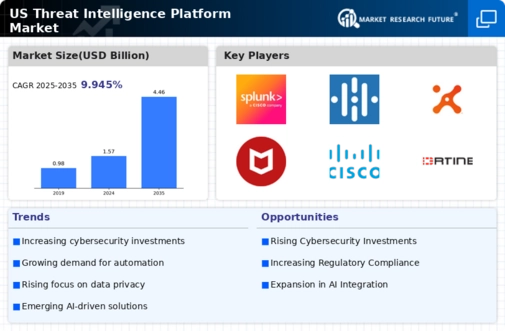Rising Cybersecurity Threats
The increasing frequency and sophistication of cyber threats is a primary driver for the threat intelligence-platform market. Organizations are facing a surge in cyberattacks, with data indicating that ransomware attacks alone have increased by over 150% in recent years. This alarming trend compels businesses to invest in advanced threat intelligence solutions to proactively identify and mitigate risks. The market is projected to reach a valuation of approximately $10 billion in 2025, reflecting a compound annual growth rate (CAGR) of around 12%. This growth underscores the urgent need for effective threat intelligence solutions to combat evolving cyber threats.
Increased Regulatory Pressures
Regulatory compliance is becoming increasingly stringent, driving demand for threat intelligence platforms. Organizations are required to adhere to various regulations, such as the General Data Protection Regulation (GDPR) and the Health Insurance Portability and Accountability Act (HIPAA). Non-compliance can result in hefty fines, which may reach up to $20 million or 4% of annual global turnover, whichever is higher. As a result, businesses are investing in threat intelligence solutions to ensure compliance and protect sensitive data. The threat intelligence-platform market is likely to see a surge in adoption as organizations prioritize compliance and risk management. This trend is expected to contribute to a market growth rate of approximately 10% annually, as companies seek to align their security strategies with regulatory requirements.
Expansion of Cloud-based Solutions
The shift towards cloud computing is influencing the threat intelligence-platform market significantly. As organizations migrate to cloud environments, they require robust security measures to protect their data and applications. Cloud-based threat intelligence platforms offer scalability, flexibility, and cost-effectiveness, making them attractive to businesses of all sizes. The market is expected to witness substantial growth, with cloud-based solutions projected to account for over 60% of total market revenue by 2025. This trend indicates a growing preference for solutions that can seamlessly integrate with existing cloud infrastructures, enhancing overall security posture. The threat intelligence-platform market is likely to benefit from this transition as organizations seek to leverage cloud technologies while maintaining robust security measures.
Growing Demand for Real-time Threat Detection
The need for real-time threat detection is a significant driver for the threat intelligence-platform market. Organizations are increasingly recognizing that traditional security measures are insufficient to combat modern threats. Real-time analytics and threat intelligence capabilities enable businesses to respond swiftly to potential breaches, minimizing damage and downtime. The market for threat intelligence platforms is projected to expand as companies invest in solutions that provide immediate insights into emerging threats. In 2025, the market is anticipated to grow by 15%, driven by the demand for enhanced situational awareness and proactive threat management. This shift towards real-time capabilities reflects a broader trend in cybersecurity, where timely information is critical for effective defense.
Increased Investment in Cybersecurity Infrastructure
Organizations are allocating more resources to enhance their cybersecurity infrastructure, which is a key driver for the threat intelligence-platform market. With the rising costs associated with data breaches, which can average around $3.86 million per incident, businesses are recognizing the importance of investing in advanced threat intelligence solutions. This trend is reflected in the increasing budgets for cybersecurity, with many organizations planning to increase their spending by 20% or more in the coming years. The threat intelligence-platform market is poised for growth as companies prioritize investments in technologies that provide comprehensive threat visibility and response capabilities. This focus on strengthening cybersecurity infrastructure is expected to propel the market forward, with a projected CAGR of 11% through 2025.

























Leave a Comment